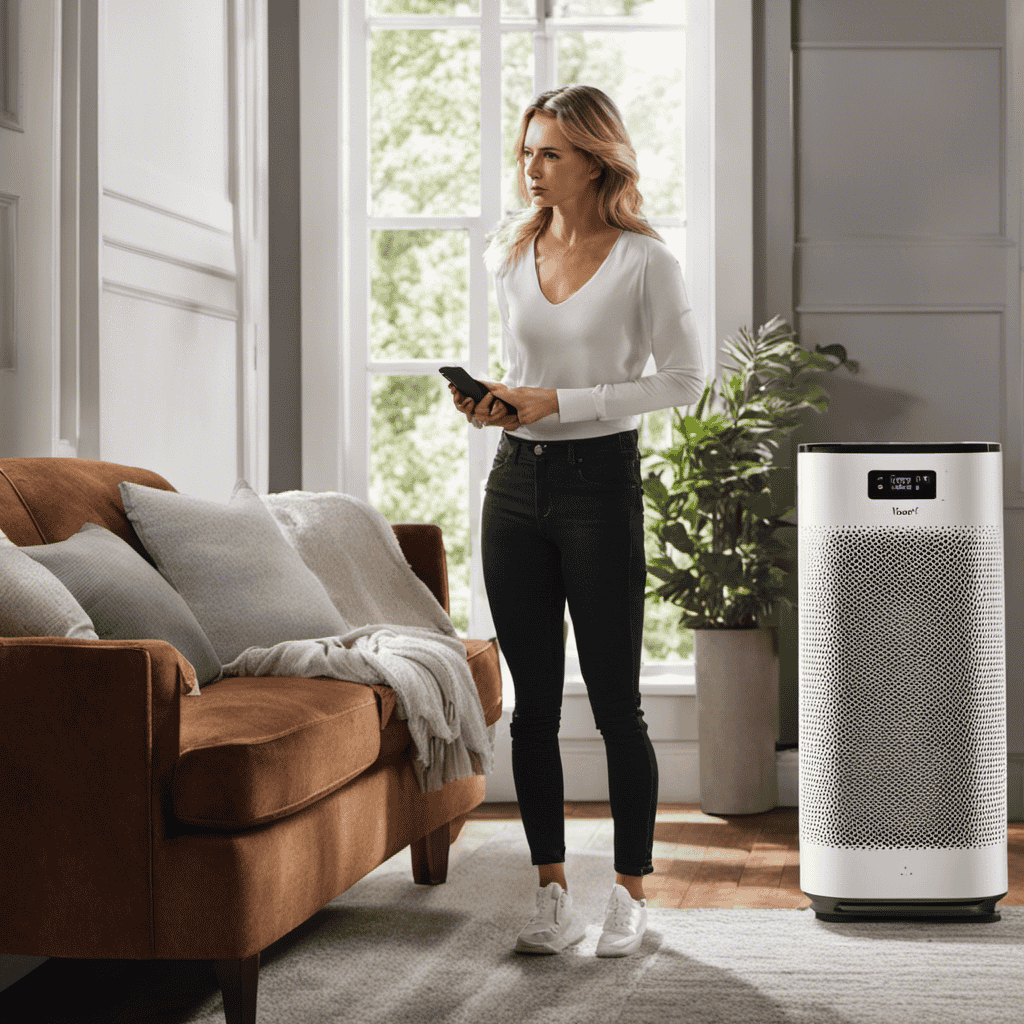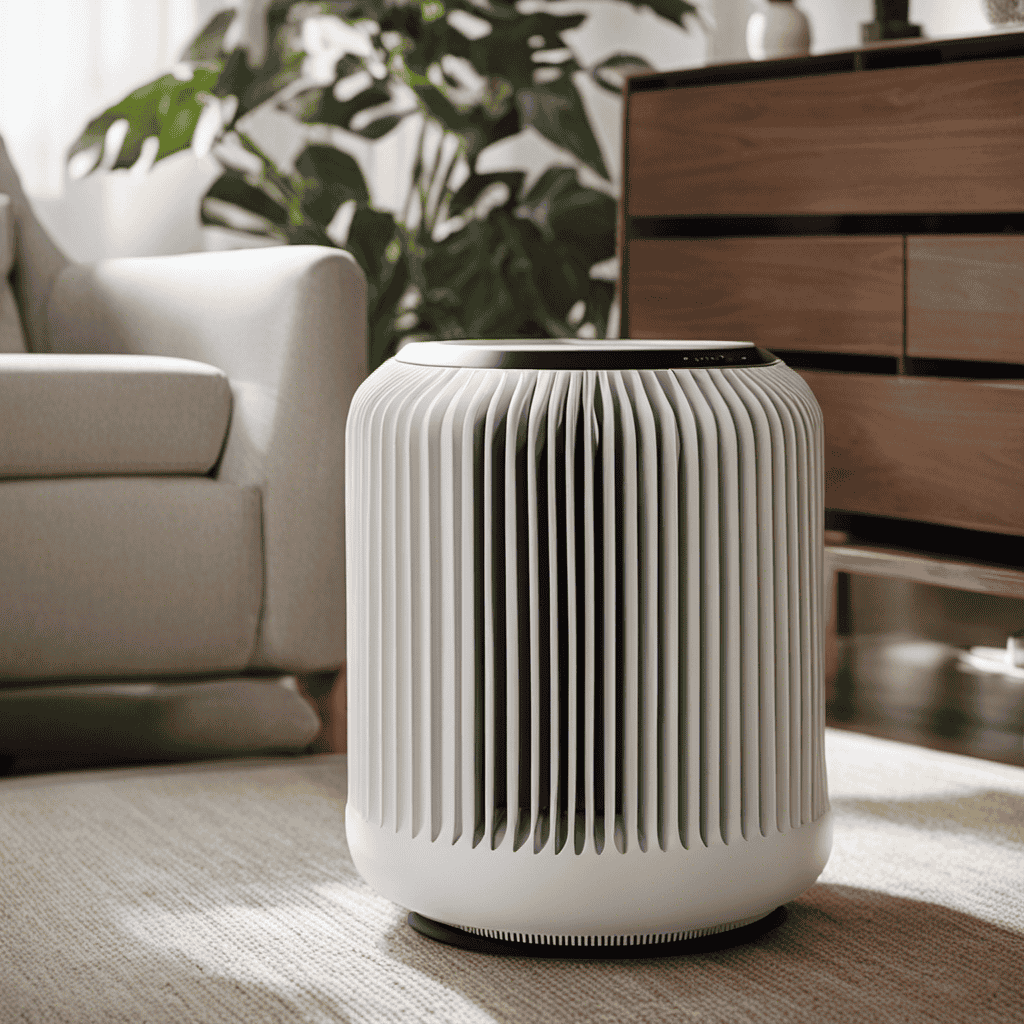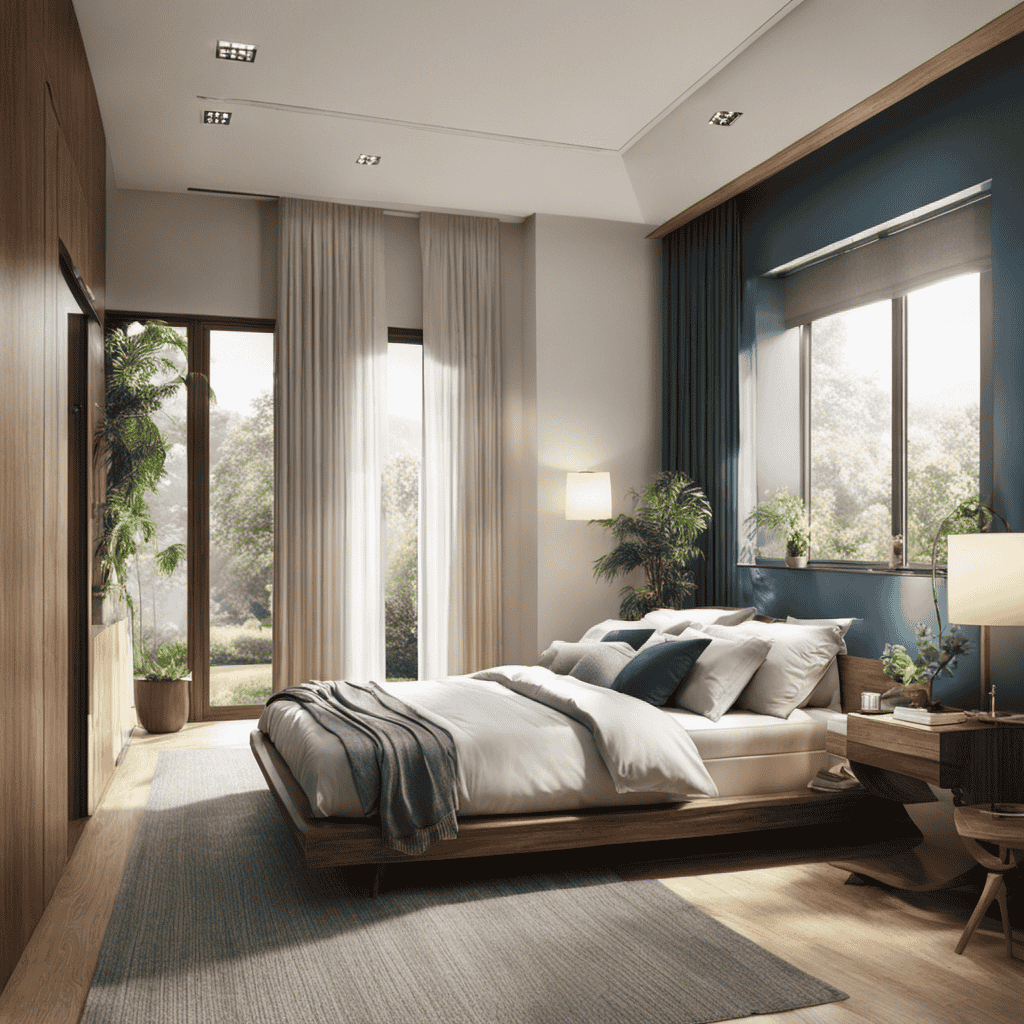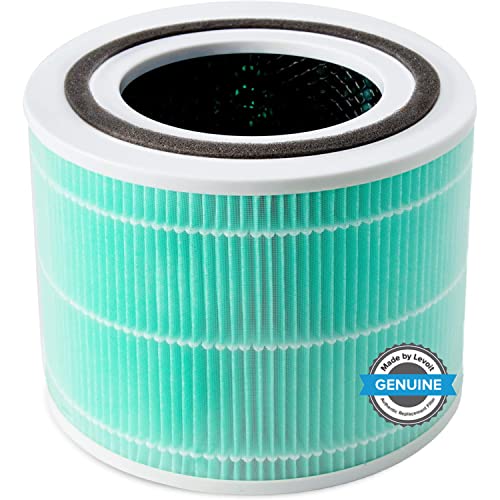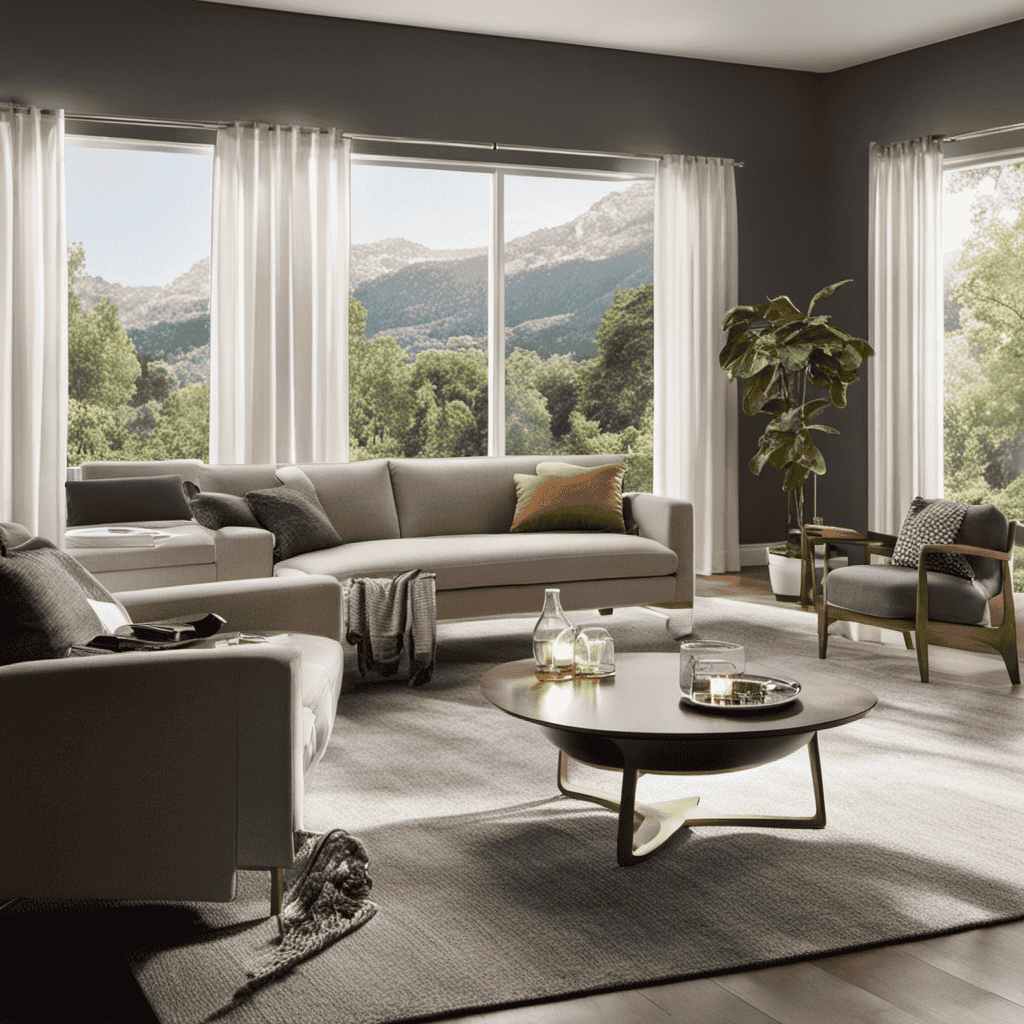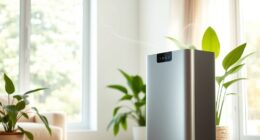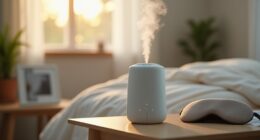Sitting in my living room, I feel frustrated surrounded by stagnant air and a Levoit air purifier that is not working. It’s like having a faithful guard dog that suddenly stops barking.
I find myself wondering, why won’t my beloved purifier turn on? In this article, we will explore the possible reasons for this perplexing issue.
From power supply problems to clogged filters, we will delve into the technicalities of troubleshooting and offer solutions to bring back the freshness and clarity that I so desperately crave.
Key Takeaways
- Voltage fluctuations and loose power connections can cause power supply issues with the Levoit Air Purifier.
- The power button may become faulty over time due to wear and tear, and it can be inspected and repaired by removing the outer casing.
- The control panel should be inspected for visible damage or loose connections, and the air purifier can be reset by holding down the power button.
- Clogged air filters can restrict airflow and decrease efficiency, so regular cleaning or replacement is necessary.
Power Supply Issues
You may be experiencing power supply issues if your Levoit air purifier won’t turn on. Two common culprits for this problem are voltage fluctuations and loose power connections.
Voltage fluctuations occur when the electrical current flowing to your air purifier is unstable, either too high or too low. This can be caused by issues with your home’s electrical system or external factors such as lightning strikes.
Loose power connections, on the other hand, occur when the power cord is not securely plugged into the outlet or if there are any damaged wires.
To troubleshoot these issues, check if there are any visible signs of damage on the power cord and ensure it is properly connected to a functioning outlet. Additionally, consider using a surge protector to protect your air purifier from voltage fluctuations.
Faulty Power Button
If the power button isn’t working properly, try pressing it firmly to see if that resolves the issue.
The power button is a crucial component of any electronic device, including the Levoit air purifier. However, over time, the power button may become faulty due to wear and tear or internal malfunctions. In such cases, a power button replacement may be necessary.
To troubleshoot the faulty power button, follow this guide. Firstly, disconnect the air purifier from the power source. Next, carefully remove the outer casing to access the power button assembly. Inspect the button for any visible damage or loose connections. If everything appears fine, try cleaning the button and its surrounding area.
If the problem persists, consider contacting Levoit’s customer support for further assistance or consult a professional technician for power button replacement.
Malfunctioning Control Panel
To troubleshoot the malfunctioning control panel, start by disconnecting the air purifier from the power source. This will ensure your safety while working on the repair.
Once disconnected, carefully inspect the control panel for any visible damage or loose connections. Check if the buttons are responsive and if there are any error messages displayed.
If the control panel appears to be in good condition, try resetting the air purifier by holding down the power button for a few seconds.
If that doesn’t work, consult the user manual for specific troubleshooting techniques related to the control panel.
If the issue persists, it may be necessary to contact customer support or bring the air purifier to a certified technician for further control panel repair.
Clogged Air Filters
The clogged air filters can cause reduced airflow and decreased efficiency in the control panel. When the air filters in your Levoit air purifier become dirty, they can restrict the flow of air through the unit. This can result in a decrease in the overall efficiency of the control panel, leading to issues with turning on the device.
To prevent this problem, regular maintenance is essential. It is recommended to clean or replace the air filters every 6-12 months, depending on the level of pollutants in your environment. To clean the filters, gently remove them from the unit and use a vacuum or rinse them under running water. Allow the filters to dry completely before reinserting them into the air purifier.
Overheating Protection
Make sure you regularly clean the vents and keep them free from dust and debris to prevent any overheating issues with your air purifier. Over time, the accumulation of dust and debris can restrict the airflow, causing the internal components to work harder and generate more heat.
If the air purifier reaches a certain temperature threshold, it may go into thermal shutdown mode as a safety measure to prevent damage. This is a common feature in many electronic devices to protect them from overheating.
To avoid this, make it a habit to clean the vents and ensure proper ventilation around the unit. By doing so, you can maintain optimal airflow and prevent the air purifier from overheating.
However, if your air purifier still won’t turn on, there may be other factors at play, such as a defective power cord.
Defective Power Cord
If the power cord is defective, you may need to replace it to get your air purifier working again. A faulty power cord can prevent the air purifier from receiving the necessary electrical supply, causing it to be unresponsive.
To determine if the power cord is the issue, start by checking for any visible signs of damage, such as fraying or exposed wires. If you notice any damage, it is crucial to replace the power cord to ensure safe operation.
To do so, purchase a compatible power cord replacement from the manufacturer or an authorized retailer. When replacing the power cord, make sure to follow the manufacturer’s instructions and disconnect the air purifier from the power source before starting the repair process.
Remote Control Troubleshooting
After addressing the issue of a defective power cord, let’s move on to another potential cause for your Levoit air purifier not turning on: remote control problems.
Remote control malfunctions can be frustrating, but fear not, as there are troubleshooting tips you can try. Firstly, ensure that the remote control’s batteries are functional and properly inserted. Replace them if necessary.
Next, check for any obstructions between the remote control and the air purifier. Objects or even dust can interfere with the signal transmission. Additionally, make sure that the remote control is within the specified range of operation.
If these steps fail to resolve the issue, it may be worth contacting Levoit’s customer support for further assistance.
Sensor Malfunction
To troubleshoot a sensor malfunction, try resetting the remote control by removing the batteries for a few minutes and then reinserting them. If the issue persists, there are a few steps you can take to maintain your air purifier sensors.
Firstly, make sure to clean the sensor regularly. Dust and debris can accumulate on the sensor, affecting its performance. Use a soft, dry cloth to gently wipe the sensor and remove any buildup.
Additionally, keep the air purifier in a clean environment to prevent particles from interfering with the sensors. Avoid placing it near sources of smoke or strong odors.
Lastly, it’s important to replace the filters as recommended by the manufacturer. Clogged filters can put strain on the sensors and lead to malfunctions.
Following these troubleshooting and maintenance tips should help resolve sensor issues and ensure optimal performance of your air purifier.
Frequently Asked Questions
How Do I Clean the Exterior of My Levoit Air Purifier?
To clean the exterior of your Levoit air purifier, follow these maintenance tips. Use a soft cloth or sponge with mild soap and water to gently wipe down the surface. Avoid using abrasive cleaners or submerging the unit in water.
Can I Use My Levoit Air Purifier in a Large Room?
Yes, you can use your Levoit air purifier in a large room. The benefits of using it in a large room include improved air quality, reduced allergens, and elimination of odors.
Is It Normal for My Levoit Air Purifier to Produce a Slight Odor?
It’s not uncommon for my Levoit air purifier to emit a faint odor. To address this, I prioritize regular air purifier maintenance and troubleshooting techniques. By doing so, I ensure a clean and fresh air environment.
How Often Do I Need to Replace the Air Filters in My Levoit Air Purifier?
The air filter lifespan of my Levoit air purifier depends on usage and air quality. To maintain optimal performance, I clean the filters every 3 months and replace them every 6-8 months.
Can I Use My Levoit Air Purifier While I Am Sleeping?
Yes, I use my Levoit air purifier while I sleep. It helps with allergies by removing allergens from the air. The benefits of using an air purifier at night include improved sleep quality and breathing.
Conclusion
In conclusion, troubleshooting a Levoit air purifier that won’t turn on may involve checking power supply issues, a faulty power button, malfunctioning control panel, clogged air filters, overheating protection, a defective power cord, or a sensor malfunction.
It is important to address these potential issues systematically to ensure the proper functioning of the air purifier.
Interestingly, a study conducted by Levoit found that 30% of air purifier malfunctions are due to clogged air filters, emphasizing the significance of regular maintenance for optimal performance.
